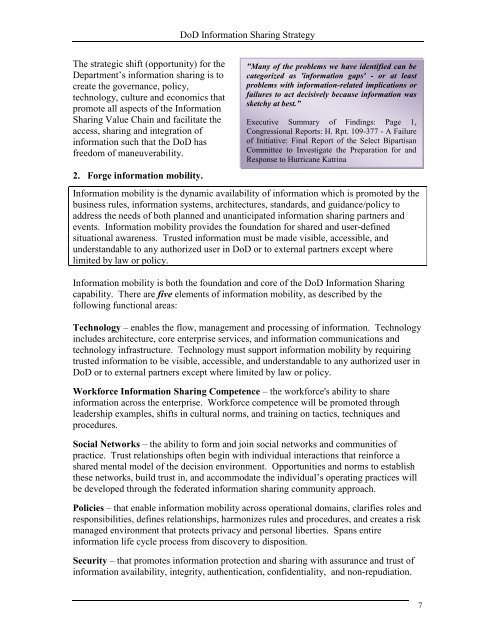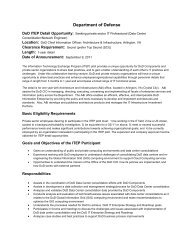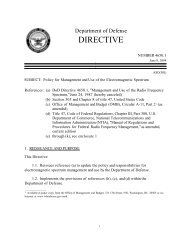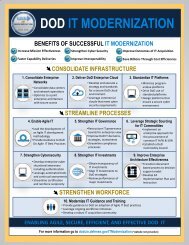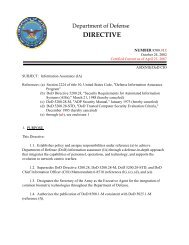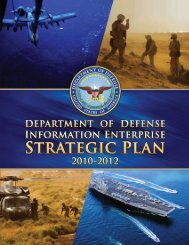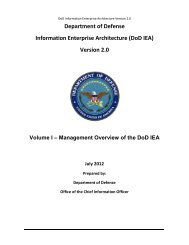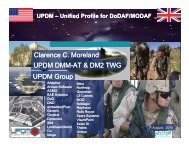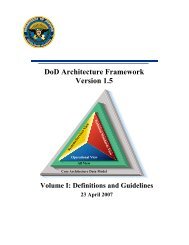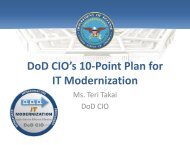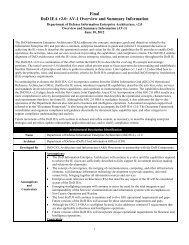DOD Info Sharing Strategy - Chief Information Officer
DOD Info Sharing Strategy - Chief Information Officer
DOD Info Sharing Strategy - Chief Information Officer
Create successful ePaper yourself
Turn your PDF publications into a flip-book with our unique Google optimized e-Paper software.
DoD <strong>Info</strong>rmation <strong>Sharing</strong> <strong>Strategy</strong>The strategic shift (opportunity) for theDepartment‟s information sharing is tocreate the governance, policy,technology, culture and economics thatpromote all aspects of the <strong>Info</strong>rmation<strong>Sharing</strong> Value Chain and facilitate theaccess, sharing and integration ofinformation such that the DoD hasfreedom of maneuverability.2. Forge information mobility."Many of the problems we have identified can becategorized as 'information gaps' - or at leastproblems with information-related implications orfailures to act decisively because information wassketchy at best.”Executive Summary of Findings: Page 1,Congressional Reports: H. Rpt. 109-377 - A Failureof Initiative: Final Report of the Select BipartisanCommittee to Investigate the Preparation for andResponse to Hurricane Katrina<strong>Info</strong>rmation mobility is the dynamic availability of information which is promoted by thebusiness rules, information systems, architectures, standards, and guidance/policy toaddress the needs of both planned and unanticipated information sharing partners andevents. <strong>Info</strong>rmation mobility provides the foundation for shared and user-definedsituational awareness. Trusted information must be made visible, accessible, andunderstandable to any authorized user in DoD or to external partners except wherelimited by law or policy.<strong>Info</strong>rmation mobility is both the foundation and core of the DoD <strong>Info</strong>rmation <strong>Sharing</strong>capability. There are five elements of information mobility, as described by thefollowing functional areas:Technology – enables the flow, management and processing of information. Technologyincludes architecture, core enterprise services, and information communications andtechnology infrastructure. Technology must support information mobility by requiringtrusted information to be visible, accessible, and understandable to any authorized user inDoD or to external partners except where limited by law or policy.Workforce <strong>Info</strong>rmation <strong>Sharing</strong> Competence – the workforce's ability to shareinformation across the enterprise. Workforce competence will be promoted throughleadership examples, shifts in cultural norms, and training on tactics, techniques andprocedures.Social Networks – the ability to form and join social networks and communities ofpractice. Trust relationships often begin with individual interactions that reinforce ashared mental model of the decision environment. Opportunities and norms to establishthese networks, build trust in, and accommodate the individual‟s operating practices willbe developed through the federated information sharing community approach.Policies – that enable information mobility across operational domains, clarifies roles andresponsibilities, defines relationships, harmonizes rules and procedures, and creates a riskmanaged environment that protects privacy and personal liberties. Spans entireinformation life cycle process from discovery to disposition.Security – that promotes information protection and sharing with assurance and trust ofinformation availability, integrity, authentication, confidentiality, and non-repudiation.7


